Physical Address
304 North Cardinal St.
Dorchester Center, MA 02124
By far, the most common epithelial malignancies of the vulva are squamous carcinomas and their precursor lesions. The remaining tumors are more rare and include adenosquamous carcinomas; adenocarcinomas, including metastatic ( Box 7.1 ) Bartholin gland; and neuroendocrine carcinomas.
Vulvar neoplasms with glandular differentiation
Adenosquamous carcinoma
Paget disease
Ectopic breast carcinoma
Adnexal carcinomas
Microcystic carcinoma
Adenocystic basal cell carcinoma
Ductal eccrine carcinomas
Clear cell hidradenocarcinoma
Apocrine carcinoma
Eccrine porocarcinoma
Bartholin gland carcinoma
Adenoid cystic carcinoma
Epithelial-myoepithelial carcinoma
Adenocarcinoma
Metastatic adenocarcinoma
Urethral neoplasms
Adenosquamous carcinoma of skin appendages is a well-known variant of squamous cell carcinoma that occurs primarily in sun-exposed areas of the head and neck and rarely metastasizes. The following are unique about the vulvar variant:
Based on the report by Lasser et al. in 1974, the vulvar variant was associated with a high rate of metastatic disease, which is not surprising given the behavior of squamous carcinomas in this site. Since their report, an additional series has confirmed the aggressive behavior of this neoplasm and the importance of distinguishing it from conventional squamous carcinoma.
Adenosquamous carcinomas have been proposed to arise from the mucin-producing cells of the hair shafts. An alternative explanation is selective redifferentiation within a conventional squamous carcinoma. Some have been reported in association with hidradenomas, although such an occurrence is exceedingly rare.
Adenosquamous carcinoma is uncommon and comprised 18 of 135 cases of vulvar cancer in one study. In the author's experience, conspicuous glandular differentiation is present in well under 10% of vulvar squamous carcinomas.
Adenosquamous carcinoma is not associated with human papillomavirus (HPV), although this is based on relatively few cases. In one study, a minority of cases (1 out of 16) have scored positive. The relatively older mean age (between 65 and 70 years old) and association with chronic vulvar inflammatory disease further supports a pathogenesis that does not include HPV.
All tumors involve the labium majus, and most also involve the minus.
The tumors are usually discovered in an advanced state and in the majority, glandular differentiation is present in both primary and metastatic tumor. Underwood et al. observed that none of their patients presented with T1 disease and that two-thirds were T3 or higher when diagnosed.
Histologically, adenosquamous carcinoma exhibits a subtle blend of columnar and squamous differentiation, the former composed of spaces lined by one to two cell layers ( Fig. 7.1 ). The squamous component may exhibit acantholysis and desquamation of dyskaryotic cells into glandular spaces.
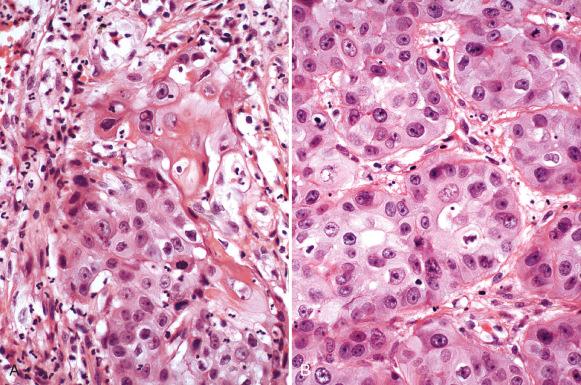
When considering the diagnosis of adenosquamous carcinoma of the vulva, the pathologist should exclude the following:
Conventional squamous carcinomas with acantholysis, areas of desquamation, or solid components, which can produce a pseudoglandular appearance.
Invasive Paget disease or other adnexal carcinomas, which appear decidedly columnar in origin.
Amelanotic malignant melanomas, which can mimic adenosquamous tumors but can usually be distinguished by the presence of melanoma in situ and positivity with appropriate immunostains (HMB-45).
The prognosis of adenosquamous carcinoma is considered poorer than conventional squamous carcinoma, although this is based on few reports. Management is similar to that of squamous carcinoma of comparable stage (see Chapter 6 ).
Paget disease accounts for less than 2% of vulvar neoplasms. The average age in most series is approximately 65 years old; the majority of patients are older than 50 years old when diagnosed. The most common symptom is vulvar pruritus, which predates diagnosis by 1 to 17 years. Paget disease of the vulva, or any site, is characterized by infiltration of the squamous mucosa or adnexa by mucin-producing neoplastic cells. The disease presumably originates in the appendages, and evidence supports both an apocrine and eccrine ductal origin. In the breast, this process is usually associated with an underlying intraductal or invasive adenocarcinoma. However, in the vulva, the majority of cases are not associated with invasion; approximately 20% have a coexisting invasive adenocarcinoma, which is either the source of or sequelae to the intraepithelial lesion.
The disease may involve the labium majus or minus, perineum, or anus and clinically appears as an eczematoid, erythematous, sometimes ulcerated lesion ( Fig. 7.2 ).
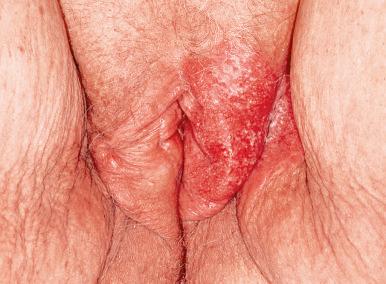
Histologically, vulvar Paget disease is characterized by large oval to polyhedral cells with pale cytoplasm, large nuclei, and small nucleoli. The cells are arranged either singly or in large clusters or nests within the epithelium, where they may be interspersed with normal squamous epithelial cells with or without hyperkeratosis and squamous pearls ( Fig. 7.3 ). Extensive sectioning will virtually always uncover focal involvement of the adnexal glands, and it is this constant feature that further supports an origin in these structures ( Fig. 7.4 ). The tumor cells are characteristically positive for mucin, CK-7, carcinoembryonic antigen (CEA), and Her-2-neu ( Fig. 7.5 ).
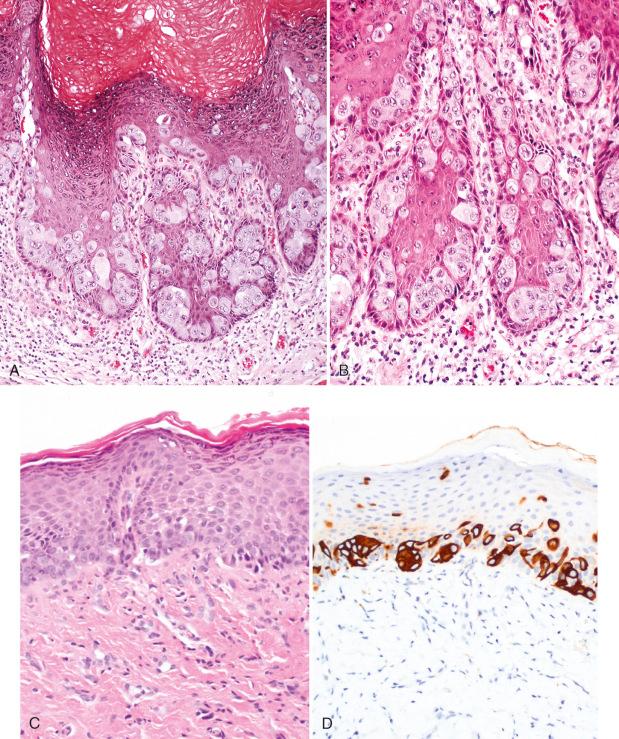
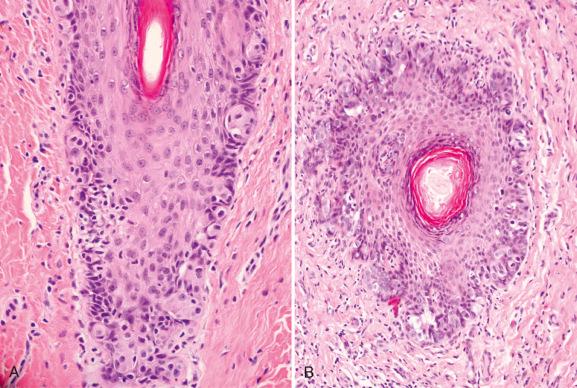
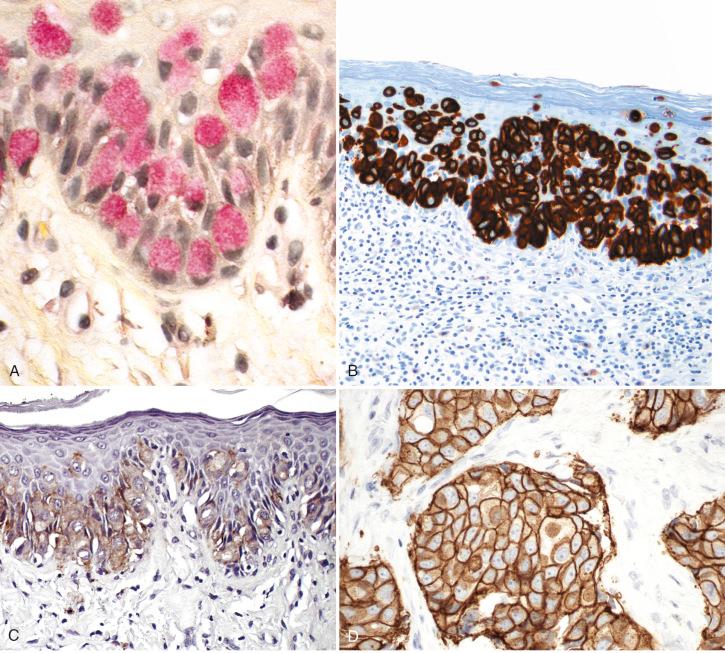
Important considerations in the laboratory and clinical management of Paget disease include the following:
Associated squamous lesions: Brainard and Hart reported a diverse array of squamous epithelial alterations associated with Paget disease of the vulva. Most were benign squamous proliferations, including acanthosis (termed squamous hyperplasia not otherwise specified [NOS] ), and mixed stromal epithelial alterations, including “fibroepithelioma-like hyperplasia” and papillomatous hyperplasia ( Fig. 7.6A and B ). The authors suggested that these alterations should prompt a search for Paget disease, although the specificity of these changes is unknown. However, they also observed occasional coexisting squamous neoplasms, including rare HPV-positive squamous carcinomas in association with Paget disease.
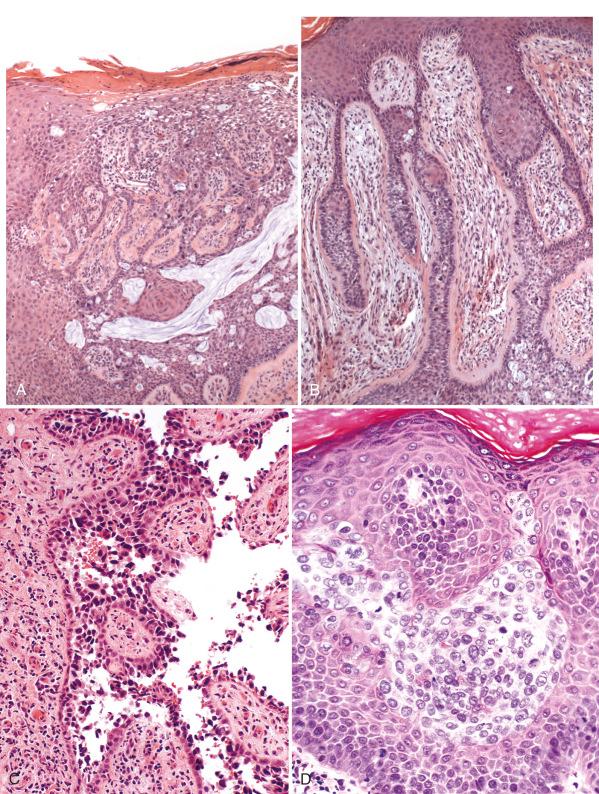
Excluding mimics: Paget disease must be distinguished from several other entities. The first is malignant melanoma (see Chapter 8 , Fig. 8.20 , Fig. 8.21 , Fig. 8.22 , Fig. 8.23 , Fig. 8.24 , Fig. 8.25 ). Both Paget disease and melanoma invade the epidermis, extend into skin appendages, and may even be sloughed in the superficial keratin. Although they can be distinguished by a mucin stain, immunostaining with HMB-45 (melanoma) and CEA (Paget disease) will confirm the diagnosis. The second is misclassification as an acantholytic dermatosis (see Fig. 7.6C ). A third is pagetoid vulvar intraepithelial neoplasia (VIN) of squamous origin (see Fig. 7.6D ). This can be distinguished by markers of squamous (p63) differentiation and the absence of mucin.
Another pitfall is direct extension of an urothelial carcinoma to the vulvar mucosa. This rare disorder may be impossible to distinguish from Paget disease on first examination. The distinction is made immunohistochemically by a staining profile of GCDFP+ and CK7+/CK20− in vulvar Paget disease versus GDFP− CK7+/CK20+ in urothelial neoplasia ( Figs. 7.5 and 7.7 ). Keep in mind that GATA3 is expressed in both Paget disease and urothelial carcinoma.
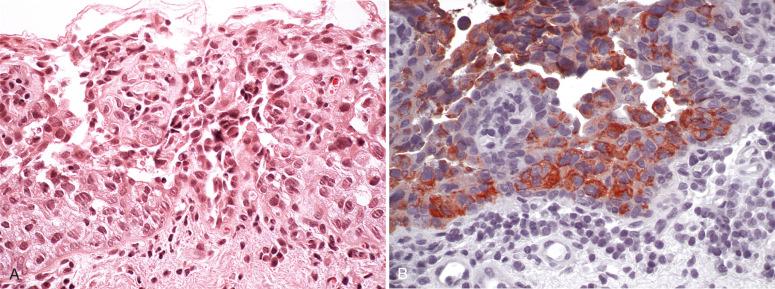
Excluding invasion on histologic examination: Because Paget disease develops at the epithelial–stromal interface and extends into adnexal structures, the exclusion of invasion may be particularly difficult for the pathologist. This problem is greatest when individual cells are seen in the superficial stroma or when inflammation obscures the tumor cell stromal interface. Invasion is characterized by dis-cohesive groups of tumors cells infiltrating into the underlying dermis or submucosa ( Fig. 7.8 ).
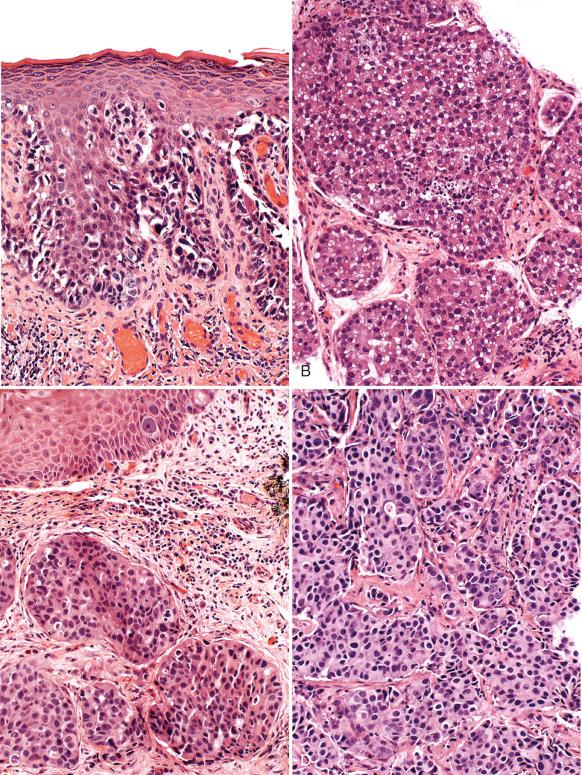
The possibility of an underlying invasive neoplasm: In the majority of cases of Paget disease associated with cancer, the underlying cancer is diagnosed initially and is of similar histology. Rarely, squamous carcinomas have been reported in association with Paget disease. One case of primary carcinoma of the Bartholin gland with secondary involvement of the overlying epithelium has been reported. Mortality is closely related to the depth of invasion.
Depth of invasion: Crawford et al. correlated outcome with depth of invasion in 10 cases of invasive vulvar Paget disease. Of seven patients with dermal invasion less than 1.0 mm, none died of their disease. Of three patients with invasion exceeding 1.0 mm, all had nodal metastases. This underscores the importance of carefully staging patients with any invasion present. One study noted that invasion of the reticular dermis produced a sharp drop in survival (100% to 33%).
Extent of epithelial spread: The major problem posed by Paget disease is the extensive distribution of the lesion. Inasmuch as Paget disease spreads freely through the network of epithelia, conventional excision will frequently be inadequate and the lesion will recur. Adamson and Reisenfield emphasized this problem in their observation that clinically uninvolved skin frequently contained histologic evidence of neoplasia. Moreover, uninvolved skin adjacent to negative margins could also be involved. However, Taylor et al. noted that if careful histologic examination revealed negative margins, recurrence rates were low. Pierie et al. noted recurrences in 42% and significant association with positive margins requiring as many as six excisions in some patients. This underscores the importance of margin assessment ( Fig. 7.9 ).
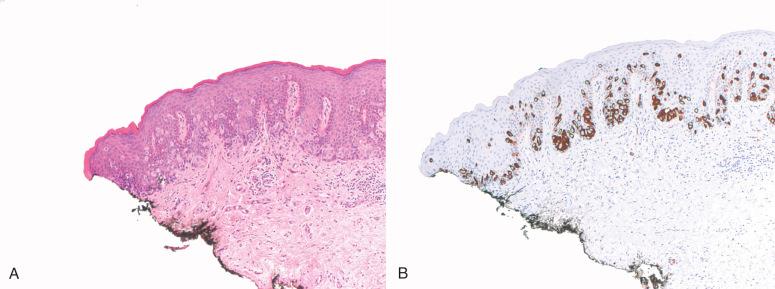
Risk of subsequent invasion: The risk of subsequent invasion is low once concurrent invasive tumor has been excluded. Hart and McMillan noted a single patient who was followed for nearly 11 years. In these unusual cases, the invasion occurs via disruption of the basement membrane with primary dermal invasion.
Risk of breast or other carcinomas: Friedrich et al. summarized the literature and noted that of 78 reported cases of vulvar Paget disease, 14 were associated with carcinoma of the breast. In a few cases, there was coexisting Paget disease at both sites. Aside from the similarity in embryogenesis and functional anatomy in the two sites, the reason for this frequent association is unknown. It should be stressed that the ratio (14 : 78) could reflect biased reporting inasmuch as coexisting breast and vulvar neoplasms may be the subject of case reports. Pierie et al. noted either breast or other carcinomas in 42% of patients. Overall mortality was not increased compared with patients of similar age, however.
The majority of patients are treated by local excision and reconstruction if necessary, but nonsurgical approaches with follow-up are also permitted. Some reports have attempted management with imiquimod with some success. As mentioned previously, Paget disease may coexist with or mimic squamous carcinoma in situ. Management of vulvar Paget disease should entail the exclusion of underlying cancer, careful histologic mapping to determine whether residual disease is present, and careful follow-up with the expectation that the disease will recur.
Become a Clinical Tree membership for Full access and enjoy Unlimited articles
If you are a member. Log in here